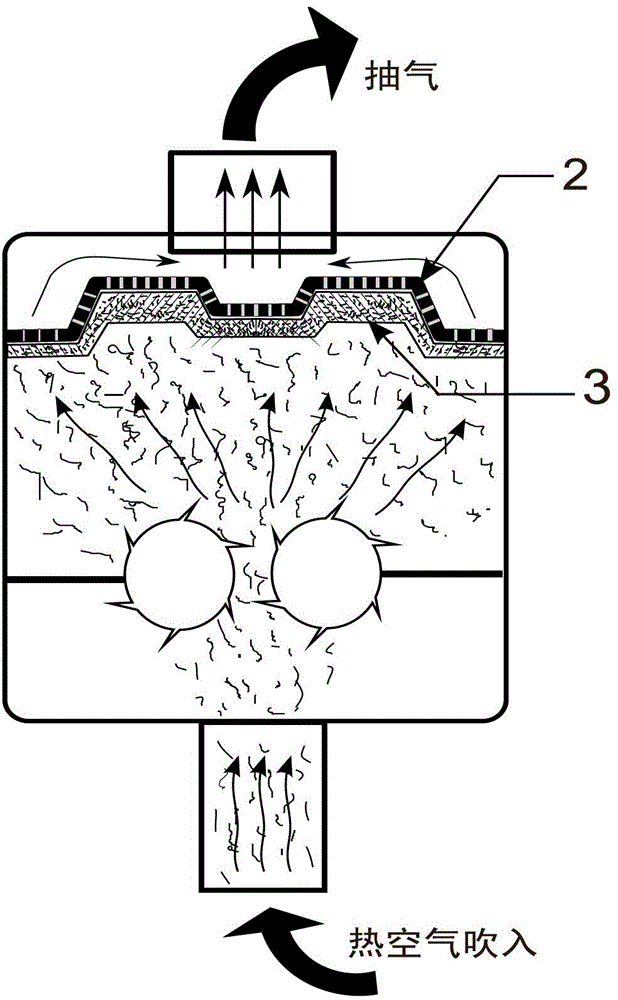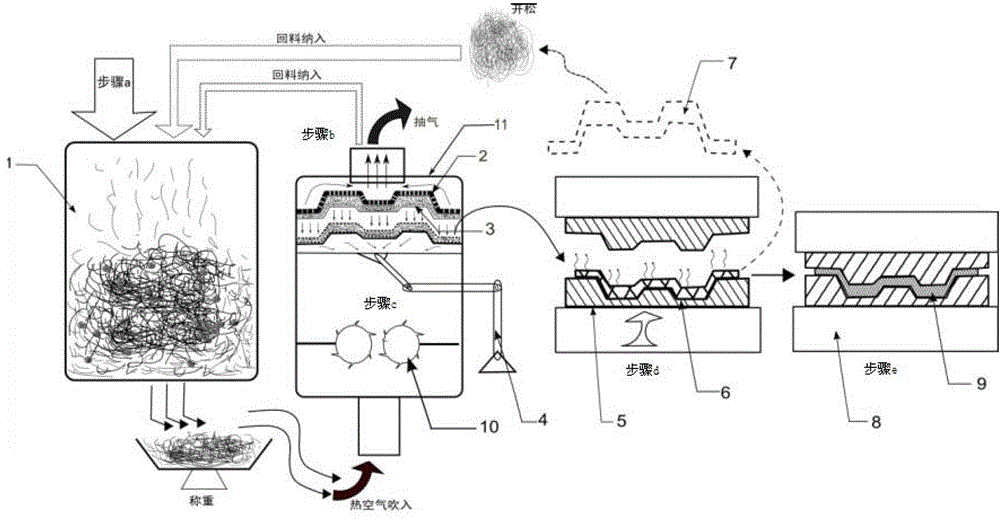A kind of method for preparing automobile noise-reducing felt
A technology for noise reduction and felt, applied in the field of preparation of automobile noise reduction felt, can solve the problems of high production cost, many production processes of a single piece of cotton felt, and limited extension, so as to improve material utilization, improve VOC performance, and improve The effect of comfort
- Summary
- Abstract
- Description
- Claims
- Application Information
AI Technical Summary
Problems solved by technology
Method used
Image
Examples
Embodiment 1
[0031] The bulk density of the designed felt product is 60kg / m 3 , the calculated raw material required after mixing is 4.5kg:
[0032] a. Opening treatment: Weigh 3 parts of man-made fiber cellulose ester fiber, 4 parts of regenerated cotton fiber, 2.5 parts of low-melting point thermoplastic fiber polyethylene fiber and 0.5 part of elastic broken sponge particles, first carry out opening treatment, and cluster The man-made fiber, regenerated cotton fiber and low-melting point thermoplastic fiber are broken up into fluffy fiber filaments, and the agglomerate elastic crushed sponge particles are broken up into loose sponge particles, and the broken up materials are sent into a large warehouse 1 for mixing. Get mixed raw materials;
[0033] b. Preforming: Weigh 4.5 kg of the mixed raw material; in the preforming bin 11, the mixed raw material obtained in step b is further broken up by the feeding mechanism 10, and the mixed raw material is blown in with the hot air blown from ...
Embodiment 2
[0039] The bulk density of the design felt is 50kg / m 3 , the calculated raw material required after mixing is 3.5kg:
[0040] a. Opening treatment: Weigh 3 parts of man-made fiber protein fiber, 4 parts of recycled cotton fiber, 2.8 parts of low-melting point thermoplastic fiber polyester fiber and 0.2 part of elastic crushed sponge particles, and first perform the opening treatment, and the clustered man-made Fiber, regenerated cotton fiber and low-melting thermoplastic fiber are broken up into fluffy fiber filaments, and the agglomerated elastic crushed sponge particles are broken up into loose sponge particles. After the mixed raw materials;
[0041] b. Preforming: Weigh 3.5 kg of the mixed raw material; in the preforming bin 11, the mixed raw material obtained in step b is further broken up by the feeding mechanism 10, and the mixed raw material is blown in with the hot air blown from the bottom of the preforming bin 11. The temperature of the hot air sprayed to the pref...
Embodiment 3
[0047] The bulk density of the design felt is 75kg / m 3 , the calculated raw material required after mixing is 6.0kg:
[0048] a. Opening treatment: Weigh 2 parts of man-made fiber acrylic fiber, 4 parts of regenerated cotton fiber, 3 parts of low-melting point thermoplastic fiber polyester and 1 part of elastic crushed sponge particles, first carry out opening treatment, clustered man-made fiber, recycled Cotton fibers and low-melting thermoplastic fibers are broken up into fluffy fiber filaments, and the lumpy elastic crushed sponge particles are broken up into loose sponge particles. The broken up materials are sent to a large warehouse (1) for mixing to obtain mixed raw materials;
[0049] b. Preforming: Weigh 6.0 kg of the mixed raw material; in the preforming bin 11, the mixed raw material obtained in step b is further broken up by the feeding mechanism 10, and the mixed raw material is blown in with the hot air blown from the bottom of the preforming bin 11. Spray in t...
PUM
| Property | Measurement | Unit |
|---|---|---|
| density | aaaaa | aaaaa |
| melting point | aaaaa | aaaaa |
| length | aaaaa | aaaaa |
Abstract
Description
Claims
Application Information
 Login to view more
Login to view more - R&D Engineer
- R&D Manager
- IP Professional
- Industry Leading Data Capabilities
- Powerful AI technology
- Patent DNA Extraction
Browse by: Latest US Patents, China's latest patents, Technical Efficacy Thesaurus, Application Domain, Technology Topic.
© 2024 PatSnap. All rights reserved.Legal|Privacy policy|Modern Slavery Act Transparency Statement|Sitemap


